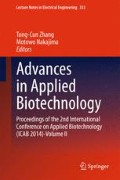Abstract
To assess the genetic diversity among five microorganisms (namely, DSL(CS)-01, DSL(CS)-02, DSL(PDA)-C, DSL(PDA)-E, DSL(PDA)-F), RAPD (random amplified polymorphic DNA) analysis was performed. Seven primers with stable polymorphisms were screened from 64 primers. PCR was carried out with the seven primers. The data indicated that the molecular markers gave different levels of polymorphism. 94 RAPD bands were obtained and out of them 64 were polymorphic bands (68.09 %) and the best primer screened was b8. The primer b8 was considered as the most effective RAPD marker for the five microorganisms above. The dendrogram built on the basis of data from RAPD analysis represented the genetic distances among the five microorganisms. Understanding the genetic variability among the microorganisms opens up a possibility for developing a molecular genetic map that will lead to the application of marker-assisted selection tools in genetic improvement of the microorganisms.
Access this chapter
Tax calculation will be finalised at checkout
Purchases are for personal use only
References
Ahmad N, Munir I, Khan I et al (2007) PCR-based genetic diversity of rape seed germplasm using RAPD markers. Biotechnology 6(3):334–338
Chao J, Zhang X (2005) Technical progress and development in liquor-making industry in China. Liquor-Making Sci Technol 5:10–16
Chen Y (2013) Analysis of technical development trend in liquor-making industry. Liquor-Making Sci Technol 3:11–13
Du L, Rao J, Tang C et al (2010) Application of cellar functional microbes in Luzhou flavour liquor production. Liquor Making 37(6):43–44
Du L, Wang Y, Rao J et al (2009) Studies on the culture and application of cellar mud complex functional microorganism. Liquor Making 36(5):35–36
Guo K (2002) Investigation on value of research and the reasons of microbial biodiversity of Mao-tai liquor. Liquor Making 29(2):36–38
Jiang H (2003) Research and prospect of the brewing microbial diversity of Mao-tai-favour liquor in the ecological environment. Liquor Making 30(4):22–24
Li X (2004) Review of development and trend of Chinese liquor. Liquor Making 1:9–10
Li Z, Wang D, Ma M et al (2010) Comparison of enzymes species and fermentation performance of different liquor starter. Liquor-Making Sci Technol 1:17–22
Nei M (1972) Genetic distance between populations. American. Nature 106:183–292
Wang C, Shi D, Gong G (2008) Microorganisms in Daqu: a starter culture of Chinese Mao-tai-flavour liquor. World J Microbiol Biotechnol 24(10):2183–2190
Wang R, Guan F, Yu H et al (2001) The research for application of dried active pit mud function microbe in production of heavy fragrant Chinese spirits. Liquor Making 28(6):35–36
Wang S, Dong Y, Li T et al (2006) The method of DNA effective and quick means for DNA extraction of taxol producing fungi. J Sci Teach Coll Univ 26(1):60–64
Wang W, Jiang F, Zhao T et al (2014) Technical progress of liquors of the main flavour types. Liquor-Making Sci Technol 3:88–89
Zhuang M, Wang Z (2003) Separation, breeding selection and taxonomic determination of functional bacteria strain B3-1 from high temperature Daqu starter for Mao-tai-flavour liquors. Liquor Making 30(5):26–28
Zeng Z (2002) On the relationship favour components in liquor and quality style. Liquor Making 29(1):8–10
Acknowledgments
This work was supported by the Foundation of Hei longjiang Educational Committee (No. 12541855).
Author information
Authors and Affiliations
Corresponding author
Editor information
Editors and Affiliations
Rights and permissions
Copyright information
© 2015 Springer-Verlag Berlin Heidelberg
About this paper
Cite this paper
Wang, SW. et al. (2015). Genetic Diversity Among the Microorganisms in Daqu Used for Beidacang Liquor as Revealed by RAPD Analyses. In: Zhang, TC., Nakajima, M. (eds) Advances in Applied Biotechnology. Lecture Notes in Electrical Engineering, vol 333. Springer, Berlin, Heidelberg. https://doi.org/10.1007/978-3-662-46318-5_11
Download citation
DOI: https://doi.org/10.1007/978-3-662-46318-5_11
Published:
Publisher Name: Springer, Berlin, Heidelberg
Print ISBN: 978-3-662-46317-8
Online ISBN: 978-3-662-46318-5
eBook Packages: Chemistry and Materials ScienceChemistry and Material Science (R0)

